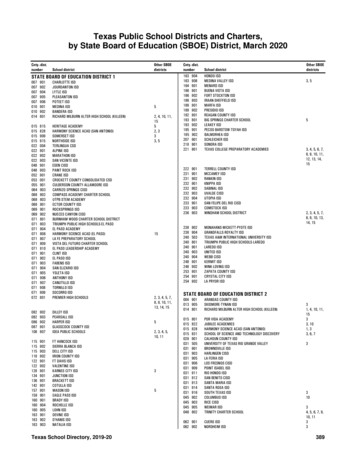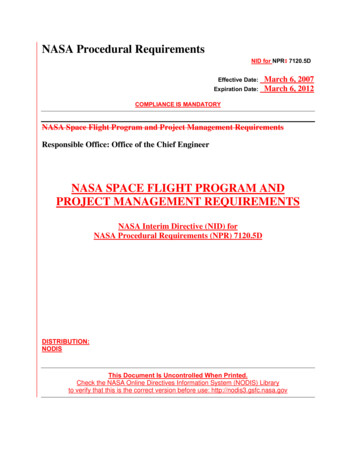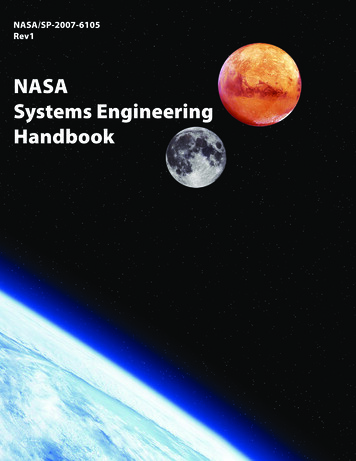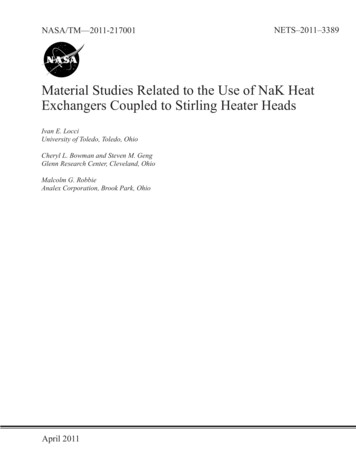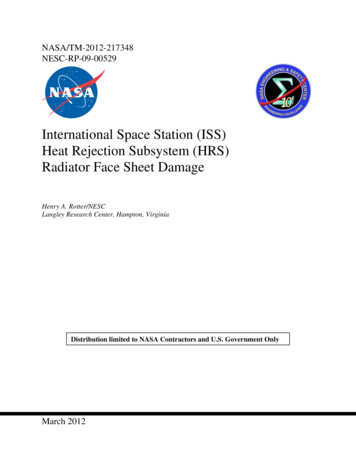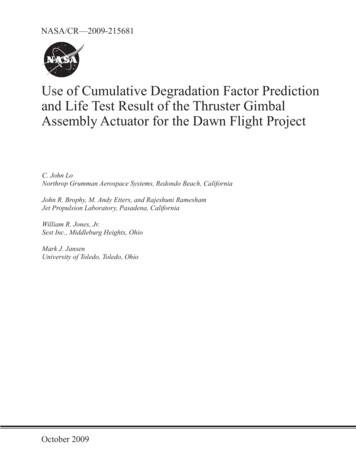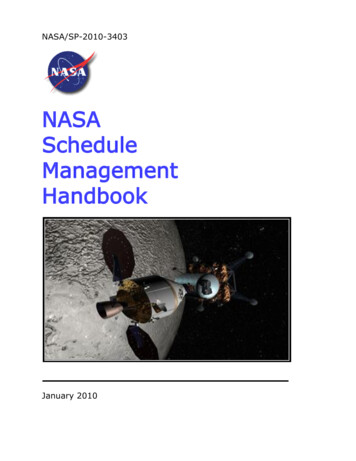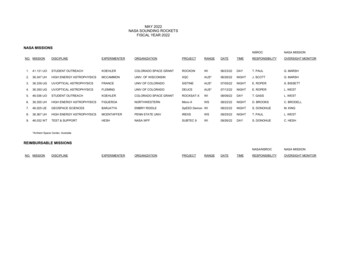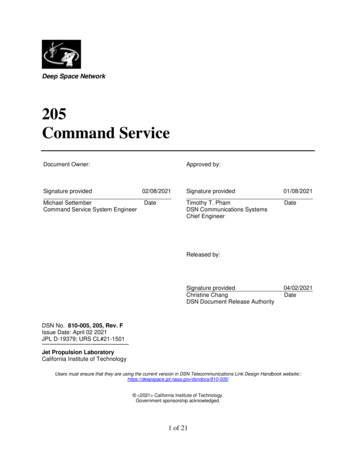
Transcription
Deep Space Network205Command ServiceDocument Owner:Approved by:Signature provided02/08/2021Michael SettemberCommand Service System EngineerDateSignature provided01/08/2021Timothy T. PhamDSN Communications SystemsChief EngineerDateReleased by:Signature providedChristine ChangDSN Document Release Authority04/02/2021DateDSN No. 810-005, 205, Rev. FIssue Date: April 02 2021JPL D-19379; URS CL#21-1501Jet Propulsion LaboratoryCalifornia Institute of TechnologyUsers must ensure that they are using the current version in DSN Telecommunications Link Design Handbook 0-005/ 2021 California Institute of Technology.Government sponsorship acknowledged.1 of 21
810-005205, Rev. FReview AcknowledgmentBy signing below, the signatories acknowledge that they have reviewed this document andprovided comments, if any, to the signatories on the Cover Page.Signature providedJeff BernerDSN Project Chief Engineer02/05/2021DateSignature not providedJ. Andrew O’DeaTracking, Telemetry, and CommandSystem Engineer2Date
810-005205, Rev. FDocument Change LogChange SummaryPrepared ByAffectedSections orpages1/15/2001Robert SniffinAllInitial ReleaseA12/15/2002Robert SniffinAllB12/15/2009A. KwokAllC6/1/2010A. KwokPage 17D12/15/2014T. CornishTable 1Provides description and capabilities of new DSNcommand equipment.Replaced DSMS with DSN. Removed references tothe decommissioned 26-m subnet.Updated Table 1 and replaced previous Figure 3with the current Figure 3, Figure 4, and Figure 5.Corrected an error in Equation (1). Eliminated theRev. E designation for the document series.Updated to current data.Added restrictions on S-band uplink from MDSCC.Deleted Ka-band uplink from DSS-25.Deleted DSS-27.Added DSS-35, -36 20 kW and DSS-26 80 kW.Changed “output of the exciter” to “output ofcommand modulator”.Added 128k and 256k data rates and removedstatement about rates above 64k beingunavailable due to exciter bandwidth restrictions(future Block 6 Exciter capabilities).Moved entire paragraph to 3.8, thus eliminatingsection 4 on “Proposed Capabilities”.Changed “will be implemented” to “is available,with some restrictions”. Added statement aboutCLTU size versus bit rate.Added DSS-36 S- and X-band.Deleted DSS-45.Added 0239-Telecomm and CLTUF.Updated Figs. 3, 4, and 5.RevIssue DateInitial3.11Was 4.1is now 3.4E11/17/2016T. CornishTable 1Section 2Appendix AF04/02/2021M. SettemberTable 1Section 2 & 3Figure 3Section 2 & 3.13Updated references.Added DSS-56 S/X-band and DSS-26 S-bandDeleted DSS-15.Updated DSS-43 power level/EIRP per upgradesRemoved Gain/ G/T column, not relevant to cmd.Updated EIRP column per subnet interface docs.Removed FCLTU “Red book”, 0163 supportRemoved emergency recording capability.
810-005205, Rev. FRevIssue DatePrepared ByAffectedSections orpagesChange SummarySection 3.2 &3.6Clarified step tuning limitations applicable to 20kWS-band only.Appendix A4Added “2010 blue book” reference.Added missing referenced 820-013 modules.
810-005205, Rev. FContentsParagraphPageContents . 51Introduction . 71.11.2Purpose. 7Scope . 72General Information . 73Command Parameters . 143.13.23.33.43.53.63.73.83.93.103.113.12RF Power . 16Carrier Frequency . 16Subcarriers . 16Direct Carrier Modulation. 16Modulation Index . 17Modulation Losses . 18PCM Data Formats . 18Subcarrier to Data Rate Ratios . 18Idle Patterns . 20Command Timing . 20Command Verification. 20Availability and Reliability . 20Appendix A References . 215
810-005205, Rev. FFiguresFigurePageFigure 1. Maximum Command Range for a Reference Spacecraft with an Omni-directionalAntenna and a 0.5 Radian Command Modulation Index. . 9Figure 2. Maximum Command Range for a Reference Spacecraft with a High-gain Antenna anda 1.2 Radian Command Modulation Index. . 10Figure 3. Space Link Extension (SLE) Forward Service Data Flow . 11Figure 4. Command Radiation Service Data Flow – File Mode (SCMF or CLTUF) . 12Figure 5. Command Delivery Service Data Flow – (CFDP) . 12Figure 6. Command Data Formats . 19TablesTablePageTable 1. Capabilities of DSN 70-m and 34-m Antennas . 8Table 2. Reference Spacecraft Characteristics for Figure 1 and Figure 2. . 9Table 3. Command Parameters . 146
810-005205, Rev. F1Introduction1.1PurposeThis module provides performance parameters for the elements of the Deep SpaceNetwork (DSN) that are exclusively used for sending commands to spacecraft. It is intended toassist the telecommunications engineer in designing an uplink (or forward space link) that iscompatible with currently installed DSN equipment. It also contains brief descriptions of futureenhancements that have been proposed for this equipment and capabilities that are beingmaintained for legacy customers using the previous generation of command equipment.1.2ScopeThe discussion in this module is limited to command equipment used with the DeepSpace Network (DSN) antennas. Detailed performance of equipment used for purposes inaddition to command is covered elsewhere in 810-005. Information on antennas, exciters, andtransmitters have been included as a convenience and should be verified against their primarysource. In particular, the following modules should be considered:101 70-m Subnet Telecommunications Interfaces,103 34-m HEF Subnet Telecommunications Interfaces,104 34-m BWG Stations Telecommunications Interfaces, and301 Coverage and Geometry.2General InformationEach antenna in the DSN is capable of sending commands to one spacecraft at a time.Each Deep Space Communications Complex (DSCC) contains one 70-m and multiple 34-mantennas. There are two types of 34-m antennas. The first is the so-called high-efficiency (HEF)antennas that have their feed, low-noise amplifiers, and transmitter located on the tilting structureof the antenna. These antennas were named when a less-efficient 34-m antenna was in use by theDSN and the name has survived. The efficiency of all DSN 34-m antennas is now approximatelythe same. The second type of 34-m antenna is the beam waveguide (BWG) antenna where thefeeds, low noise amplifiers and transmitters are located in a room below the antenna structureand the radio frequency energy is transferred to and from the antenna surface by a series ofmirrors encased in a protective tube.The capabilities of each antenna type and, in some cases, of the individual antennas aredifferent and must be considered in designing a command link. Often, the selection of antennafor uplink will depend on the downlink frequencies it supports.Table 1 lists the uplink and downlink frequency ranges for each antenna type andprovides approximate ranges for uplink Effective Isotropic Radiated Power (EIRP). The modulesreferred to above should be consulted for exact values and other parameters. Thetelecommunications link designer is cautioned against making designs dependent on the 70-mantenna, as there is only one per complex and it subject to severe scheduling constraints.7
810-005205, Rev. FTable 1. Capabilities of DSN 70-m and 34-m AntennasAntennaTypeDSS IDUplink Freq(MHz)TXR Power(W)EIRP(dBW)DownlinkFreq(MHz)DSS 24DSS 26DSS 34DSS 36DSS 54 1DSS 56S: 2025 - 2120S: 2025 - 2110S: 2025 - 2120S: 2025 - 2110S: 2025 - 2120S: 2025 - 211020,00025020,00025020,00025078.6 - 98.671.9 - 78.978.6 - 98.671.9 - 78.978.6 - 98.671.9 - 78.9S: 2200 - 2300S: 2200 - 2300S: 2200 - 2300S: 2200 - 2300S: 2200 - 2300S: 2200 - 2300Canberra, AustraliaMadrid, SpainDSS 24, 25, 26DSS 26DSS 34, 35, 36DSS 54, 55, 56X: 7145 - 7235X: 7145 - 7235X: 7145 - 7235X: 7145 - 723520,00080,00020,00020,00089.4 - 109.489.3 - 115.389.4 - 109.489.4 - 109.4X: 8400 - 8500X: 8400 - 8500X: 8400 - 8500X: 8400 - 8500Madrid, SpainDSS 65S: 2025 - 211025071.8 - 78.8S: 2200 - 2300Madrid, SpainDSS 65X: 7145 - 719020,00089.8 - 109.8X: 8400 - 8500Goldstone, CA USADSS 14S: 2110 - 212020,00085.6 - 105.6S: 2200 - 2300Canberra, AustraliaDSS 43S: 2110 - 2120100,00085.6 - 111.6S: 2200 - 2300Madrid, SpainDSS 63S: 2110 - 212020,00085.6 - 105.6S: 2200 - 2300Goldstone, CA USADSS 14X: 7145 - 719020,00095.8 - 115.8X: 8400 - 8500Canberra, AustraliaDSS 43X: 7145 - 719080,00095.8 - 121.8X: 8400 - 8500Madrid, SpainDSS 63X: 7145 - 719020,00095.8 - 115.8X: 8400 - 8500Complex/SiteGoldstone, CA USACanberra, Australia34MBWGMadrid, SpainGoldstone, CA USA34MHEF70M1Notes:1) S-band uplink in the Deep Space frequency range of 2110-2120 MHz is not available from MDSCC except forVoyager support by special agreement with the Spanish Frequency Spectrum RegulatorNOTE: 70m 400kW S-band has been decommissioned in the DSN and replaced with 100kW S-band capability.Figure 1 and Figure 2 illustrate the DSN command capabilities assuming a reference spacecraftemploying a residual carrier uplink and having the characteristics specified in Table 2. Thesefigures show that command range at low bit rates is limited by the spacecraft carrier trackingperformance. At higher bit rates, the range is limited by available Eb/No. NOTE: 70m 400kW S-band has beendecommissioned in the DSN and replaced with 100kW S-band capability.Figure 1 is intended to show performance during a spacecraft emergency that forces theuse of an omnidirectional antenna. The uplink modulation index has been intentionally loweredto 0.5 radians to direct more power to the carrier. Figure 2 assumes a more typical spacecraftconfiguration using a high-gain antenna and an uplink modulation index of 1.2 radians.8
810-005205, Rev. FNOTE: 70m 400kW S-band has been decommissioned in the DSN and replaced with 100kW S-band capability.Figure 1. Maximum Command Range for a Reference Spacecraft with an Omni-directional Antenna and a0.5 Radian Command Modulation Index.Table 2. Reference Spacecraft Characteristics for NOTE: 70m 400kW S-band has been decommissioned in the DSN and replacedwith 100kW S-band capability.Figure 1 and Figure 2.ParameterValueAntenna Gain less pointing lossOmnidirectionalS-band Hi-gainX-band Hi-gain0 dB30 dB39.7 dBOther RF losses–1.8 dBSystem Temperature500 KCarrier Loop Bandwidth100 HzRequired Carrier Margin12 dBCommand Detection Losses–1.5 dBRequired Eb/No9.6 dB9
810-005205, Rev. FNOTE: 70m 400kW S-band has been decommissioned in the DSN and replaced with 100kW S-band capabilityFigure 2. Maximum Command Range for a Reference Spacecraft with a High-gain Antenna and a 1.2Radian Command Modulation Index.Uplink data are delivered to the DSN using one of three services. The first is referred toas Stream Mode Command Radiation Service using the Space Link Extension (SLE) forwardservice, an implementation of the Consultative Committed for Space Data Systems (CCSDS)recommendation 912.1, Space Link Extension Forward Command Link Transmission Unit(CLTU) Service, and is described in DSN Document 820-013, module 0239-Telecomm. See thedata flow diagram in Figure 3.820-013, module 0239-Telecomm, which describes the DSN implementation of ForwardCLTU Service Specifications “2004 Blue Book”, CCSDS 912.1-B-2-S, and “2010 Blue Book”,CCSDS 912.1-B-3-S, and Enhanced Forward CLTU Service Specification “Orange Book”,CCSDS 912.11-O-1.The SLE forward service is an online only service including service users providingcommand symbols to be transferred to the spacecraft and ancillary information such as routing,ensuring the integrity of the Earth segment of the communications link, and providing thecustomer limited control of the command process as described in the aforementioned documents.10
810-005205, Rev. FThe second, File Mode Command Radiation Service, is provided by accessing a file ofCLTUs from the Mission Operations Center (MOC) via DSN File Store where the individualCLTUs are extracted and passed on to the Ground Station for modulation onto the uplink carrierand radiation to the spacecraft. The file of CLTUs is referred to as a Spacecraft CommandMessage File (SCMF per DSN Document 820-013, module 0198-Telecomm-SCMF), or CLTUFile (CLTUF per DSN Document 820-013, module 0241-Telecomm-CLTUF). See the data flowdiagram in Figure 4. This service is an online or offline store and forward service that allowsmanagement of multiple stored command files.The SCMF contains a layer of service provision parameters (window open/close times,allowable bit rates, modulation index, etc.) in addition to the CLTUs to be radiated. The CLTUFcontains just a simple header and the CLTUs to be radiated.In addition to the files containing the actual CLTUs, there are a number of other productsthat may optionally be exchanged between the service user and the DSN for scheduling andreporting:1) Radiation List (Rad List per DSN Document 820-013, module 0197-TelecommCMDRAD), which contains a list of SCMFs or CLTUFs to be radiated as a batch.2) SCMF Radiation Report (Rad SCMF per DSN Document 820-013, module 0191Telecomm), which is a report of SCMFs and CLTUs radiated, including information such as bit1 times, number of bits, etc.3) CLTUF Radiation Report (Rad CLTUF per DSN Document 820-013, module 0242Telecomm), which is a report of CLTUFs and CLTUs radiated, including information such asbit-1 times, number of bits, etc.The third, Command Delivery Service, uses the CCSDS File Delivery Protocol (CFDP)and is available for spacecraft that employ this protocol. It is described in DSN Document 820013, module 0213-Telecomm-CFDP. The service is provided by accessing files from the MOCvia DSN File Store where the files are converted CLTUs which are then passed to the GroundStation for modulation onto the uplink carrier and radiation to the spacecraft. See the data flowdiagram in Figure 5. This is also an online or offline service that allows generalized uplink filetransfer.DSN Tracking, Telemetryand Command SystemPROJECTCLTUs0239-TelecommCCSDS SpaceLink ExtensionForward CLTUServiceProviderFigure 3. Space Link Extension (SLE) Forward Service Data Flow11
810-005205, Rev. FFigure 4. Command Radiation Service Data Flow – File Mode (SCMF or CLTUF)DSN Tracking, Telemetry, and Command SystemCFDP CCSDS FileDelivery ProtocolPDUsCCSDS727.0-B-4Product forRadiationCFDP Transaction Request File0187-Telecomm-CFDPPROJECTDSNFileStoreProduct for esCFDP Transaction Log FileCommandPreparationand DeliveryServices0188-Telecomm-CFDPRad List0197-Telecomm-CMDRADFigure 5. Command Delivery Service Data Flow – (CFDP)120239-TelecommCCSDS SpaceLink ExtensionForward CLTUServiceProvider
810-005205, Rev. FWhen configured for Forward CLTU Service the only function performed at the stationsis the mechanism whereby command data are extracted from the delivery format and convertedto an RF signal suitable for reception by a spacecraft. This means that all commands includingprefix symbols, and command data symbols must be generated at the appropriate MOC orProject Operations Control Center (POCC). If coding such as Bose-Chaudhuri-Hocquenghem(BCH) is required, it must be accomplished before the commands are delivered to the DSN. TheDSN may perform checks for format compliance, but it will not interpret nor modify the contentsof any command. Neither does it guarantees error free command delivery to the spacecraft. It isup to the project to provide its own error detection and correction schemes.When configured for Enhanced Forward CLTU Service (Orange Book), the input streamto the DSN is in the form of Advanced Orbiter System (AOS) transfer frames. The DSN canoptionally randomize the frames, will insert user defined idle frames when no command data ispresent, will attach sync markers to the frames, and then radiate the frames in the form ofCLTUs.In addition to the interfaces by which command data are delivered to the DSN, amanagement interface is required for selecting the particular set of parameters appropriate for thespacecraft being supported. A discussion of this interface is contained in DSN Document 810007 Module 109, DSN Mission Interface Design Handbook, Service Management. (Thisdocument is still in development and not available at the time of this writing.)13
810-005205, Rev. F3Command ParametersThe following paragraphs provide a discussion of the principal command parameters.Parameters that are a function of antenna type were summarized in Table 1.Parameters that are independent of antenna type are summarized in Table 3.Table 3. Command ParametersParameterValueRemarksRF Power OutputSee Table 1Also see modules 101, 103, and 104Effective Isotropic RadiatedPower (EIRP)See Table 1Also see modules 101, 103, and 104Carrier FrequencySee Table 1Also see modules 101, 103, and 104Subcarrier FrequenciesSine waveSquare wave999 Hz – 250075 Hz100 Hz – 1000 HzThe CCSDS recommends a 16 kHz sinewave subcarrier for all data rates up toand including 8 kbps. Direct carriermodulation is recommended above 8kbps.Subcarrier FrequencyResolution0.1 HzSine wave and Square waveHarmonic and Spurious Signals(Sine wave Subcarrier) 45 dBBelow subcarrier amplitude (dB-V)Harmonic Response(Square wave Subcarrier) 6 dBAttenuation of 7th harmonic (dB-V)Subcarrier Stability 1 10–9PCM Data FormatsNRZ-L, M, SBi-φ-L, M, SFor all measurement times from 100 sthrough 12 h (derived from stationfrequency standard)See Figure 4Modulation Index RangeSine wave SubcarrierSquare wave SubcarrierNo Subcarrier0.1 – 1.52 radians0.1 – 1.40 radians0.1 – 1.57 radiansModulation Index Accuracy 10%Of carrier suppression in dBModulation Index Stability 3%Of carrier suppression in dB over a12-h period7.8 bps – 125037.5 bps7.8 bps – 500 bps8000 – 256000 bpsSubcarrier Frequency/2n, 1 n 11Data RatesSine wave SubcarrierSquare wave SubcarrierNo Subcarrier146 – 87 degrees6 – 80 degrees6 – 90 degrees
810-005205, Rev. FParameterCoherency to SubcarrierData Rate StabilityInter-command modulationIdle PatternCommand TimingPre-track CalibrationValueRemarks 6 Offset between bit/symbol transitionsand subcarrier zero crossings. 1 10–9For all measurement times from 100 sthrough 12 h (derived from subcarrierstability)None (Carrier only),carrier and commandsubcarrier, carrier,command subcarrierand idle pattern8-bit repetitiveor idle PDU0.1 s0.1 s plus 1 – 8 bit times if idle pattern ispresent20 minute5 minuteAvailabilityMean-time between CommandAbortsWith Transmitter warm-up or bandchangeTransmitter already warmed-up95%Nominal98%Mission critical events2200 h15
810-005205, Rev. F3.1RF PowerRF power is produced by solid state or variable beam klystron amplifiers that permitsaturated operation over a relatively wide power range. Refer to Table 1 for the power levelsavailable at each antenna.3.2Carrier FrequencyThe DSN considers establishment of carrier frequency to be a tracking function asopposed to a command function. Small frequency changes such as might be required for Dopplercompensation will have little effect on the transmitter output. Larger frequency changes such asmight be required to command two spacecraft within the same beamwidth may cause thetransmitter output to vary by as much as 1-dB due to ripple across the klystron passband. Shouldthis happen, the operator at the station will be warned that the transmitter should be re-calibrated.This warning may be ignored to no detriment other than the power output being as much as 1 dBfrom the requested value.The S/X 20kW capable BWG’s have two klystron amplifiers that share a common powersupply and cooling system. Therefore, a change of band will require a minimum of 20-minutes tocool-down the klystron that is no longer needed and warm-up and calibrate the other klystron.Additionally, the S-band 20kW klystron at these stations is step-tunable to provide coverage overthe entire uplink band. Changing from one band segment to another requires turning off thetransmitter, changing the band segment, and re-calibrating at the new frequency.3.3SubcarriersBoth sine wave and square wave subcarriers are available. Subcarrier frequencies areinitialized from an entry in the activity service table but may be changed during a supportactivity providing no command waveform is being radiated. This technique can be used toprovide a limited amount of subcarrier Doppler compensation recognizing that commandmodulation (including the subcarrier) must be removed when the subcarrier frequency ischanged. Changing the subcarrier frequency will cause a corresponding change in data ratebecause these two items are coherent. See the discussion on data rate for details.3.4Direct Carrier ModulationCCSDS Medium Rate Command Recommendation (CCSDS Recommendation 401.0-B,paragraph 2.2.7) is available, with some restrictions. NRZ bit rates and bi-phase symbol rates of8000, 16000, 32000, 64000, 128000, and 256000 are supported. Carrier and data suppression fordirect carrier modulation are calculated using the equations for square wave modulation (3) and(4).16
810-005205, Rev. F3.5Modulation IndexThe modulation index is established by applying a variable-amplitude voltage to thephase modulator in the exciter. The amplitude of this voltage can be adjusted in 255 steps ofapproximately 0.0065 radians. The range of 0.1 radians through 1.52 radians occupiesapproximately 220 of these steps. The modulating voltage is calibrated periodically at the 3-dBcarrier suppression point for both sine wave and square wave subcarriers. The calibration intervalis selected to assure a carrier suppression within 10% of the specified value in dB at any timebetween calibrations. For example, a sine wave modulation index of 0.67 radians (38.5 ) willproduce a carrier suppression of 1.0 dB 0.1 dB. A sine wave modulation index of 1.13 radians(64.5 ) will produce a carrier suppression of 3.0 dB 0.3 dB.The modulation index is initialized from an entry in the activity service table but may bechanged during a support activity providing no command waveform is being radiated. Carrierpower suppression and data power suppression as functions of modulation index angle are:Sine-wave subcarrier:PC(1)(dB) 10log J 20 (θ D ) , dBPT[][](2)[](3)[](4)PDdB) 10 log 2J12 (θD ) , dB {first upper and lower sidebands}(PTSquare-wave subcarrier:PC(dB) 10 log cos 2 (θ D ) , dBPTPD(dB) 10 log sin 2 (θ D ) , dB {all sidebands}PTwhereθD data modulation index, radians, peakPT total powerPC carrier powerPD data powerJ0 zero-order Bessel functionJ1 first-order Bessel Function17
810-005205, Rev. F3.6Modulation LossesThe bandpass of all elements in the command path, with the exception of the S-bandpower amplifier at the 20kW capable BWG stations, is adequate to make modulation lossesnegligible over the frequency and power ranges specified in Table 1. The modulation losses atthe S-band 20kW BWG stations are negligible provided the klystron frequency step is properlyselected.3.7PCM Data FormatsThe baseband signal is a pulse code modulated (PCM) waveform that is binary phaseshift keyed (BPSK) onto a subcarrier. That is, phase-shift keyed with a signaling level of 90 and resulting in a fully suppressed subcarrier. The six supported PCM data formats are illustratedin Figure 4. The data format is established at the start of a support activity by an entry in theactivity service table.3.8Subcarrier to Data Rate RatiosBit rates for NRZ modulation and symbol rates for bi-phase modulation are availableover the range of 7.8 to 125,037.5 bps or sps. They are derived from the subcarrier frequencygenerator using a binary divider of 2n where n can be from 1 to 11. Thus, a 7.8 bps data streamwould require a sine wave subcarrier of no more than 8000 Hz and the lowest bit rate availablefor a 1000 Hz subcarrier would be 1.953125 bps. For a 16000 Hz subcarrier, the bit or symbolrate can be between 7.8125 and 8000 bps. For a 250075 Hz subcarrier, the bit or symbol rate canbe between 122.1069 and 125037.5 bps.The data rate entry in the activity service table is rounded to the nearest acceptable valuedepending on the subcarrier frequency selected divided by 2n. If Doppler correction to thenominal subcarrier frequency and data rate are desired, it should be applied to the subcarrierfrequency only. The data rate will be correspondingly Doppler compensated, since it is thesubcarrier frequency divided by 2n, and 2n is a fixed integer. The data rate may be changedduring a support activity providing no command waveform is being radiated.18
810-005205, Rev. FFigure 6. Command Data Formats19
810-005205, Rev. F3.9Idle PatternsThe DSN command equipment can be configured to operate in three modes during acommand support activity. The command mode is initialized from an entry in the activity servicetable but may be changed during a support activity providing no command waveform (subcarrieror subcarrier and data) is being radiated. The first of these is carrier only as might be used duringa support activity not involving commands. In this mode, all command modulation is removedwhenever command data are not being radiated. The second mode is subcarrier only in which acontinuous, unmodulated subcarrier is transmitted to the spacecraft at the specified frequencyand modulation index. The third mode is a repeating customer defined 8-bit idle pattern or idleProtocol Data Unit (PDU), with or without a subcarrier. The most common idle pattern is analternating sequence of ones and zeros. If a sequence cannot be specified as an 8-bit pattern, itmust be originated at the MOC or POCC as command bits.3.10 Command TimingThe customer may specify a first bit radiation time within the command data stream to anaccuracy of 0.1 s. If an idle pattern has been specified, the actual first bit radiation time will befrom 1 to 8 bit times later than the specified radiation time, since the transition between an idlepattern and command bits can only occur at 8-bit boundaries. Commands will be radiated uponreceipt if no first bit radiation time is specified. If contiguous radiation of commands is desired, itis the customer’s responsibility to ensure that the commands are delivered at a rate sufficient tosatisfy the radiation requirements while not overflowing the buffering capability of the commandequipment. Further details can be found in 820-013 module 0239-Telecomm (SLE Command).3.11 Command VerificationNo test on data content is performed because there is no independent source of dataavailable for comparison. The transmitter power level, waveguide configuration, presence offrequency and timing references, and software health are monitored. Failure of a monitoredparameter will cause command radiation to abort. Exciter, transmitter, and microwavemonitoring may be disabled upon customer request.3.12 Availability and ReliabilityThe DSN Command System availability is 95 percent for nominal commanding and 98percent for mission critical events, achieved by allocating back-up stations. The mean timebetween command aborts is 2200 hours of command time. This number was obtained fromanalysis of several years of operational data. The number is considered valid because most abortswere caused by factors external to the command equipment.There is no history available from which an undetected command bit error rate can bedetermined but it is believed to be significantly less than 3 in 108 transmitted bits and may be aslow as 1 in 1013 which is the error rate of the communications channel between the customer andthe stations.20
810-005205, Rev. FAppendix AReferences1234567891011121314CCSDS 727.0-B-4, CCSDS file Delivery Protocol, Blue Book, January 2007.CCSDS 401.0-B-25-S, Recommendations for Radio Frequency and Modulation Systems,February 2015.CCSDS 912.1-B-2-S, Space Link Extension – Forward CLTU Service Specification,Silver Book, November 2004.CCSDS 912.1-B-3-S, Space Link Extension – Forward CLTU Service Specification,Silver
the same. The second type of 34-m antenna is the beam waveguide (BWG) antenna where the feeds, low noise amplifiers and transmitters are located in a room below the antenna structure and the radio frequency energy is transferred to and from the antenna sur
